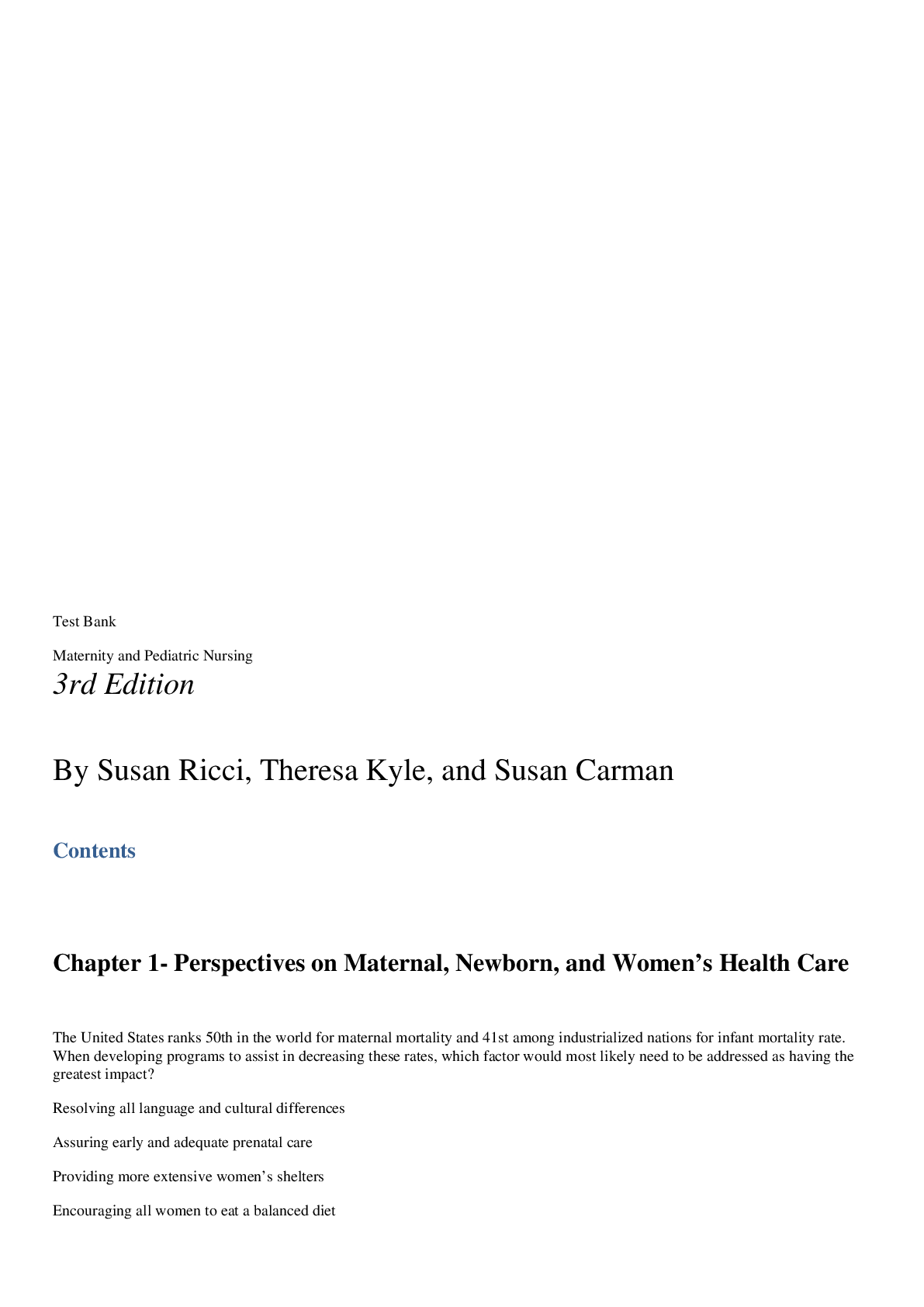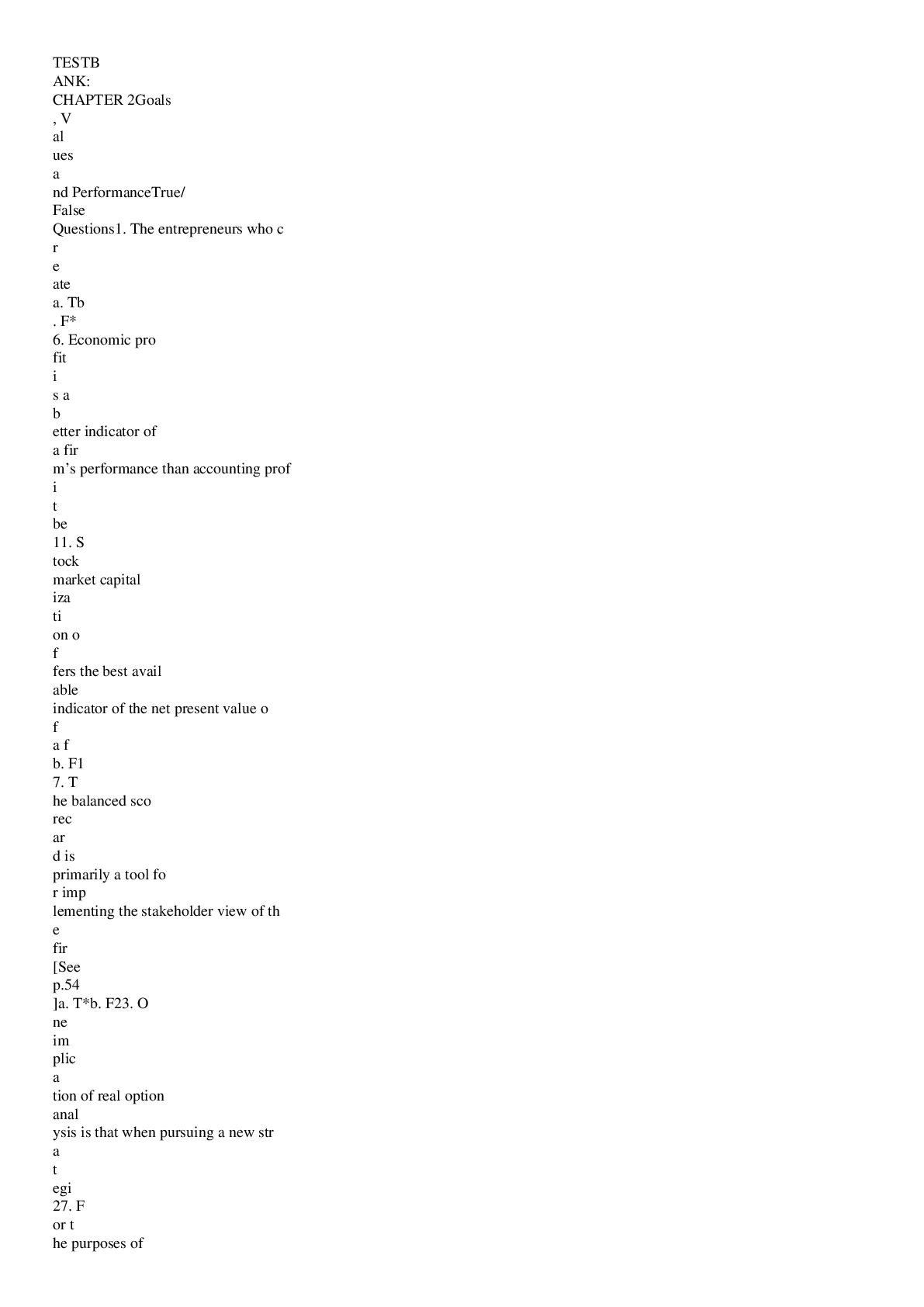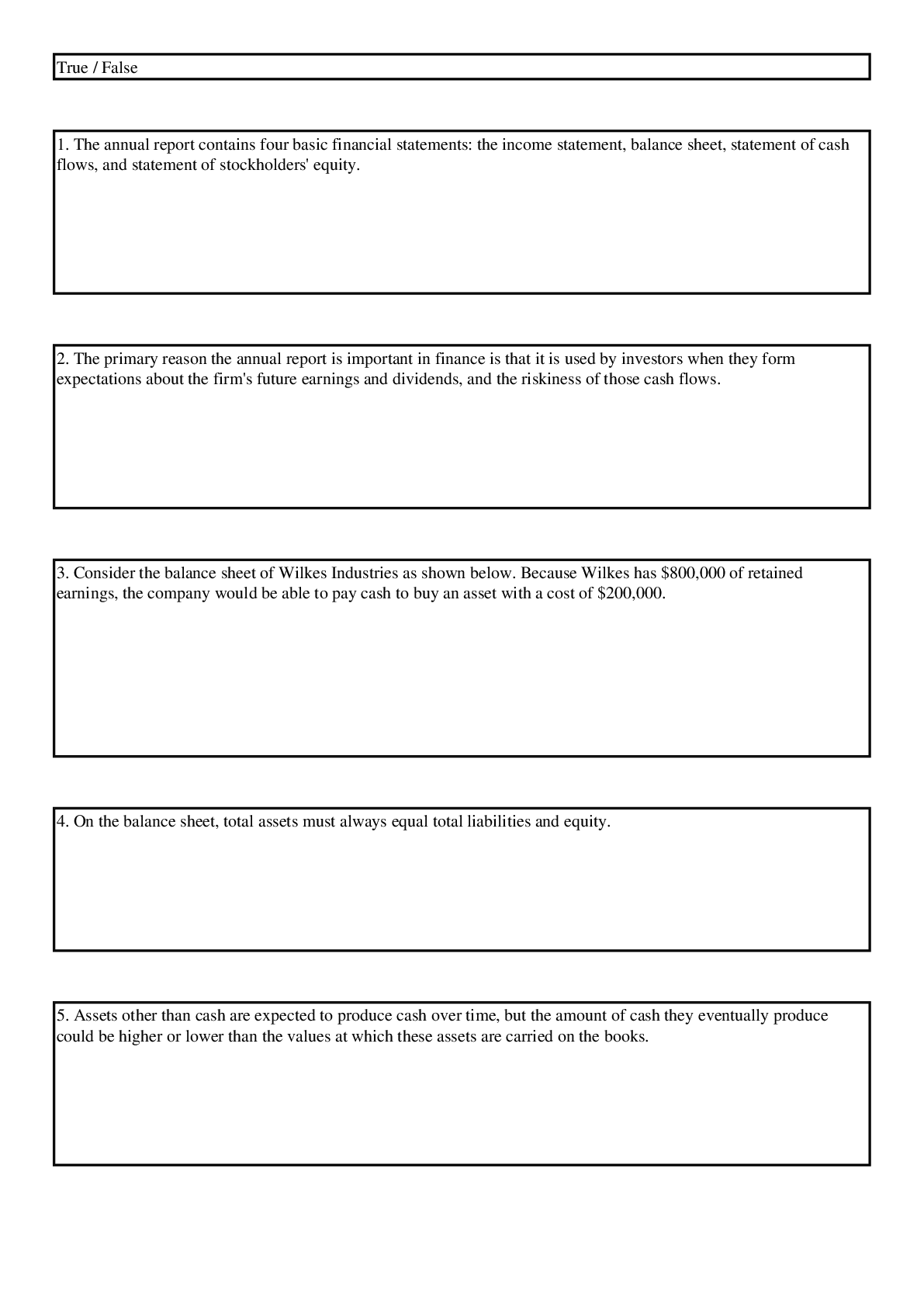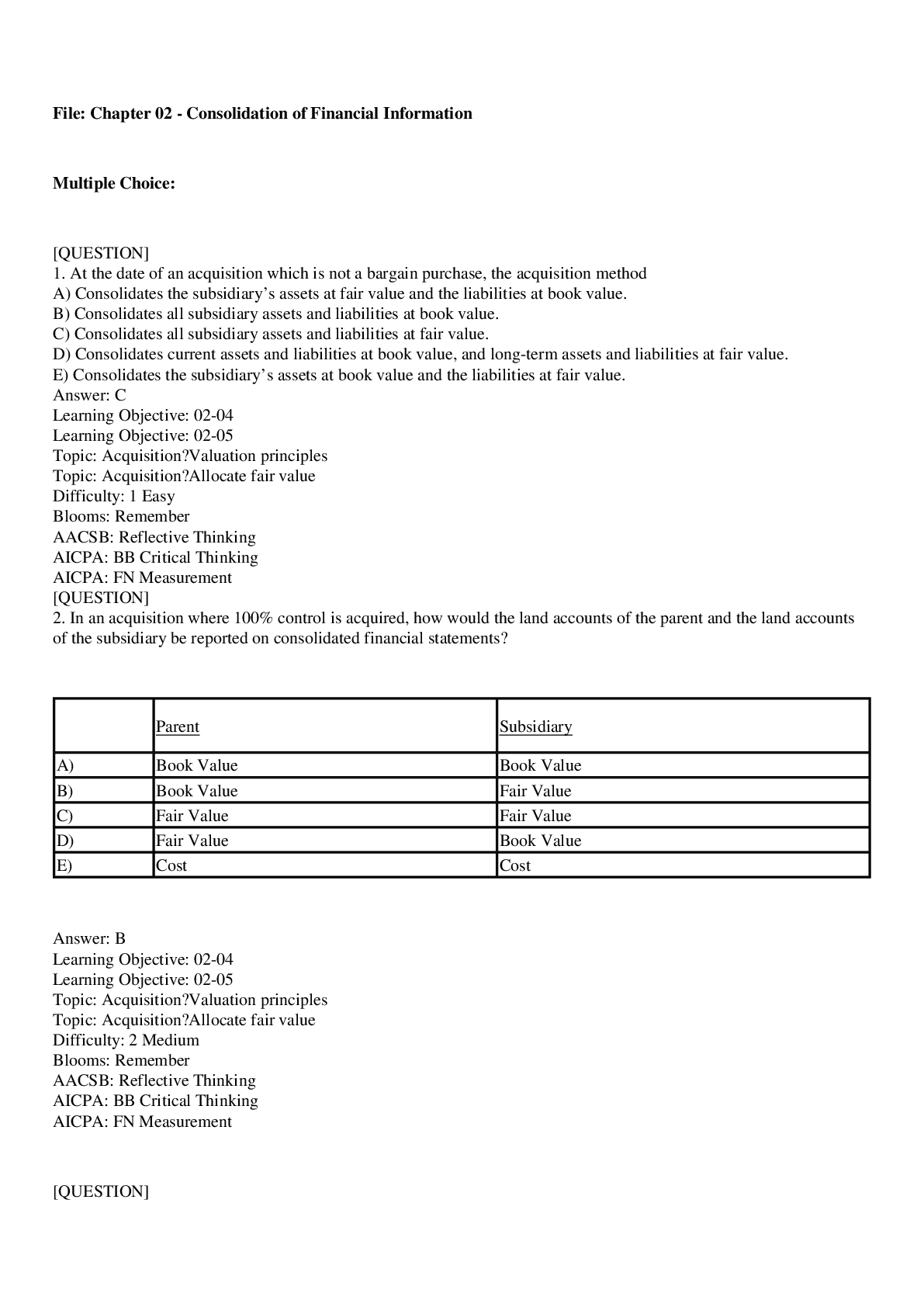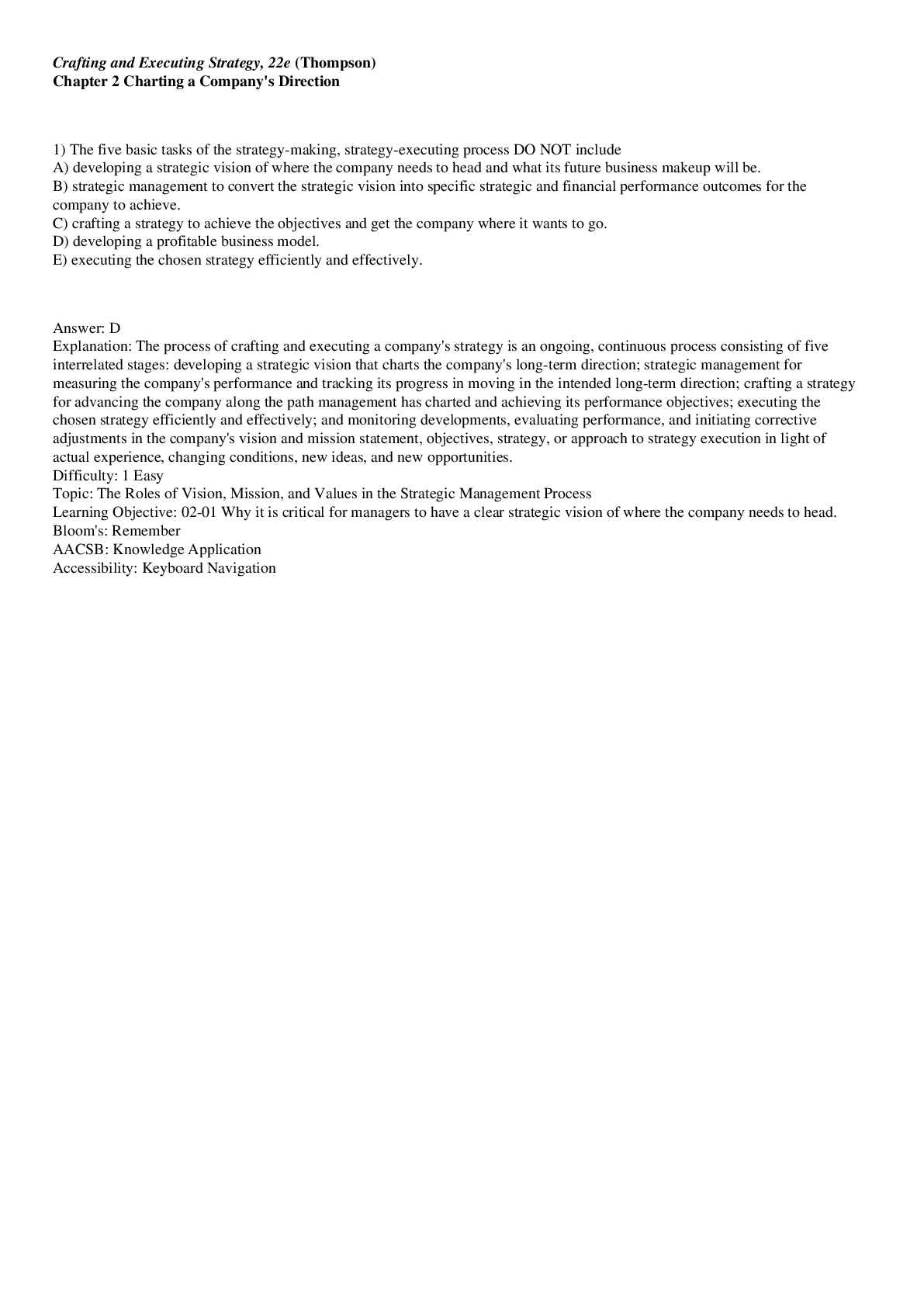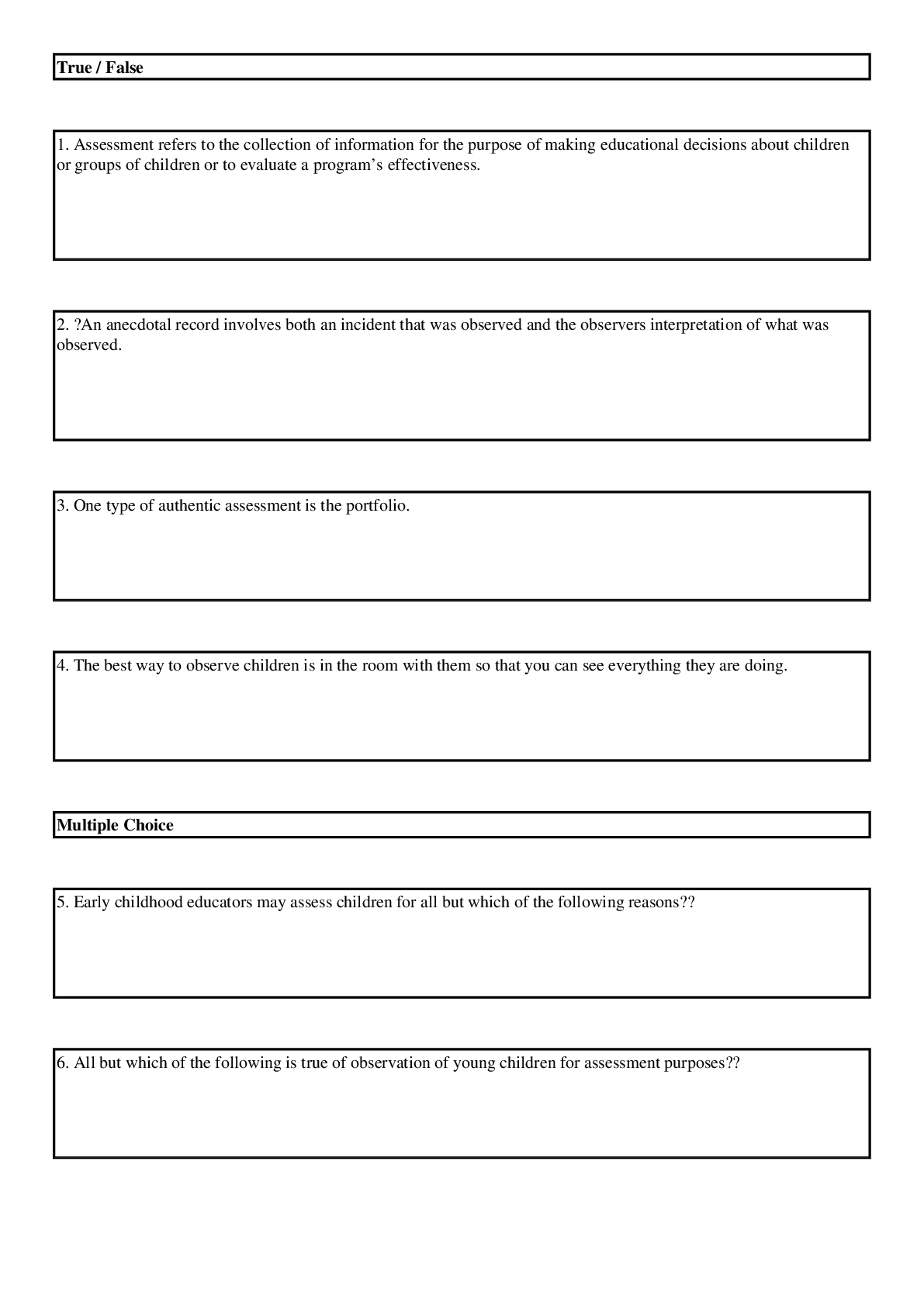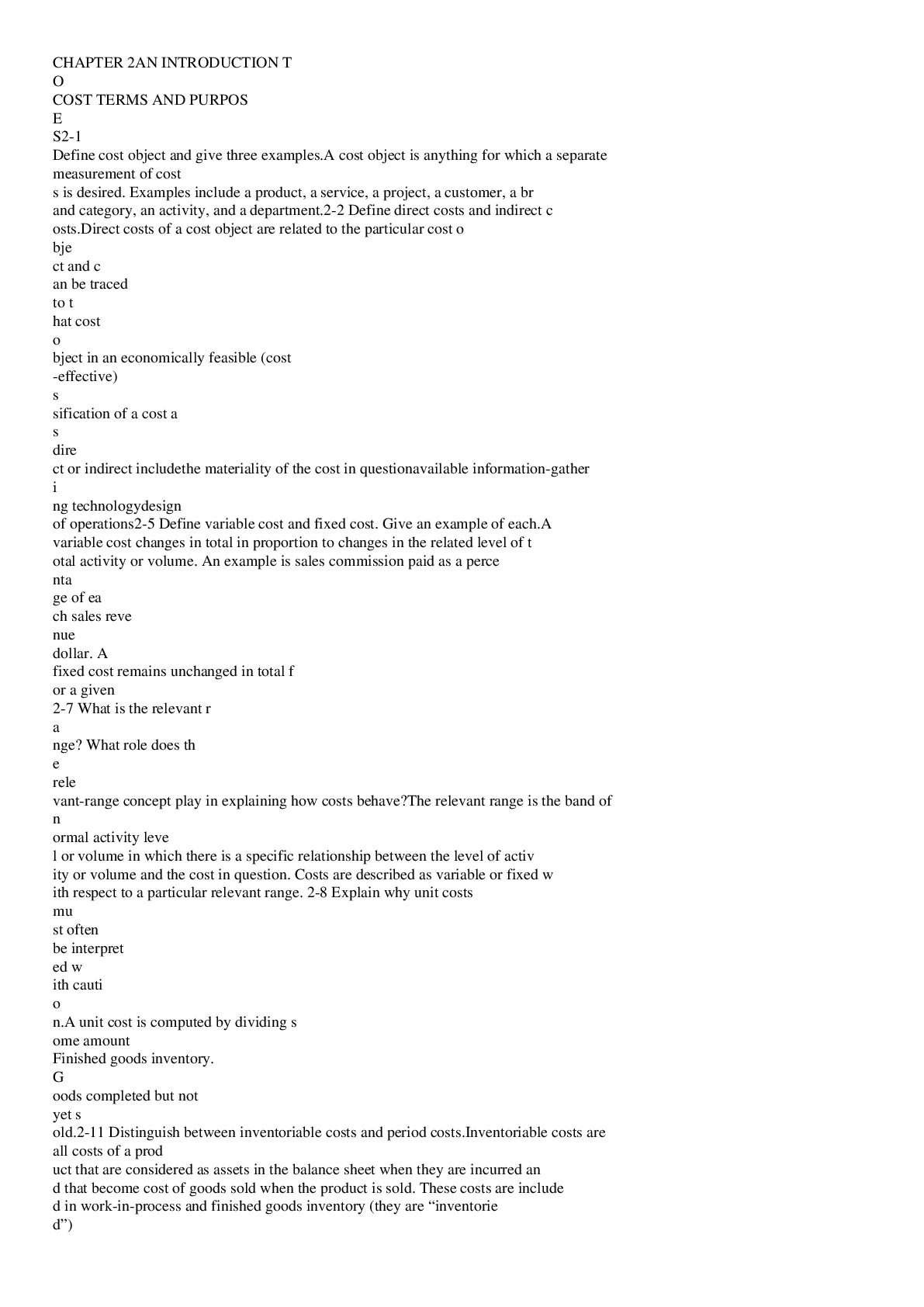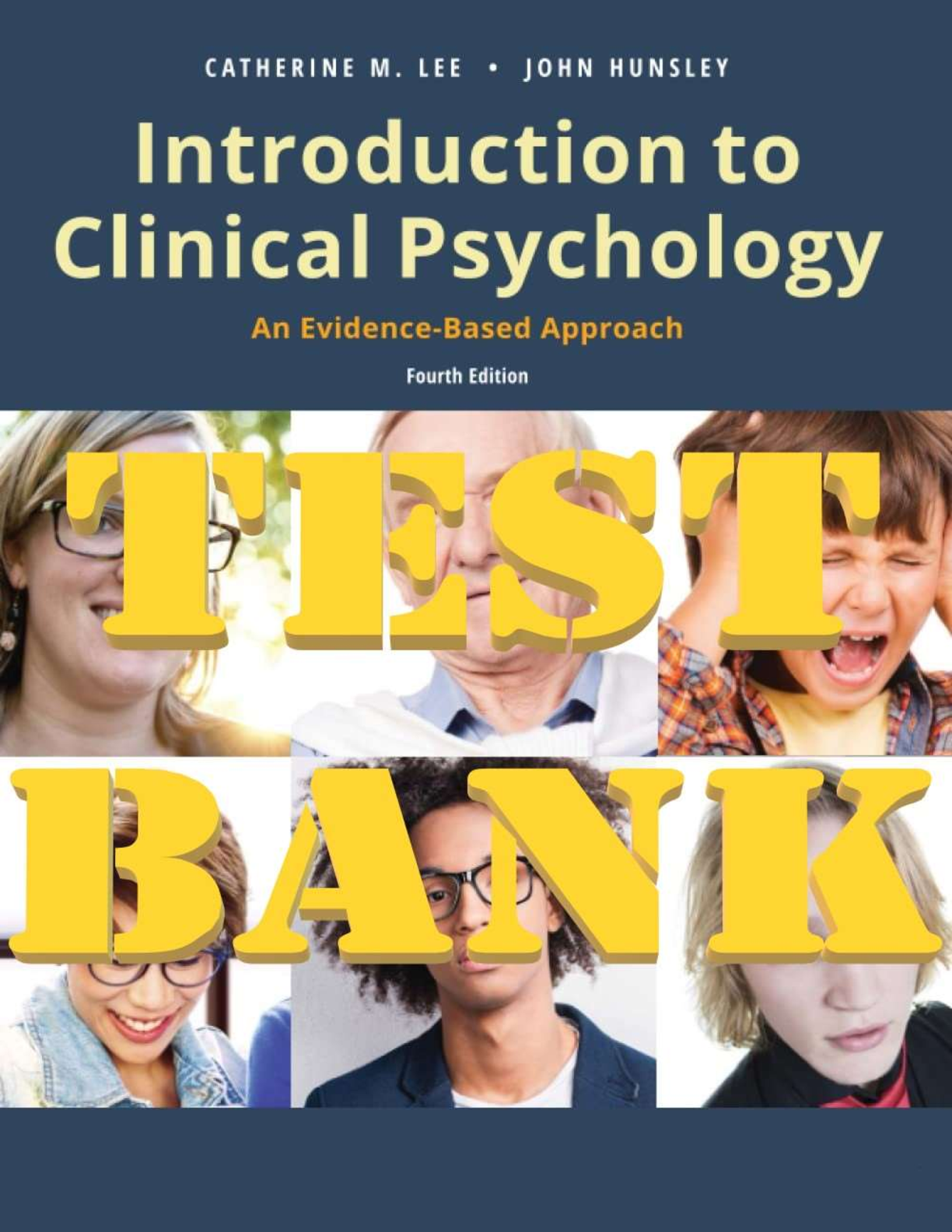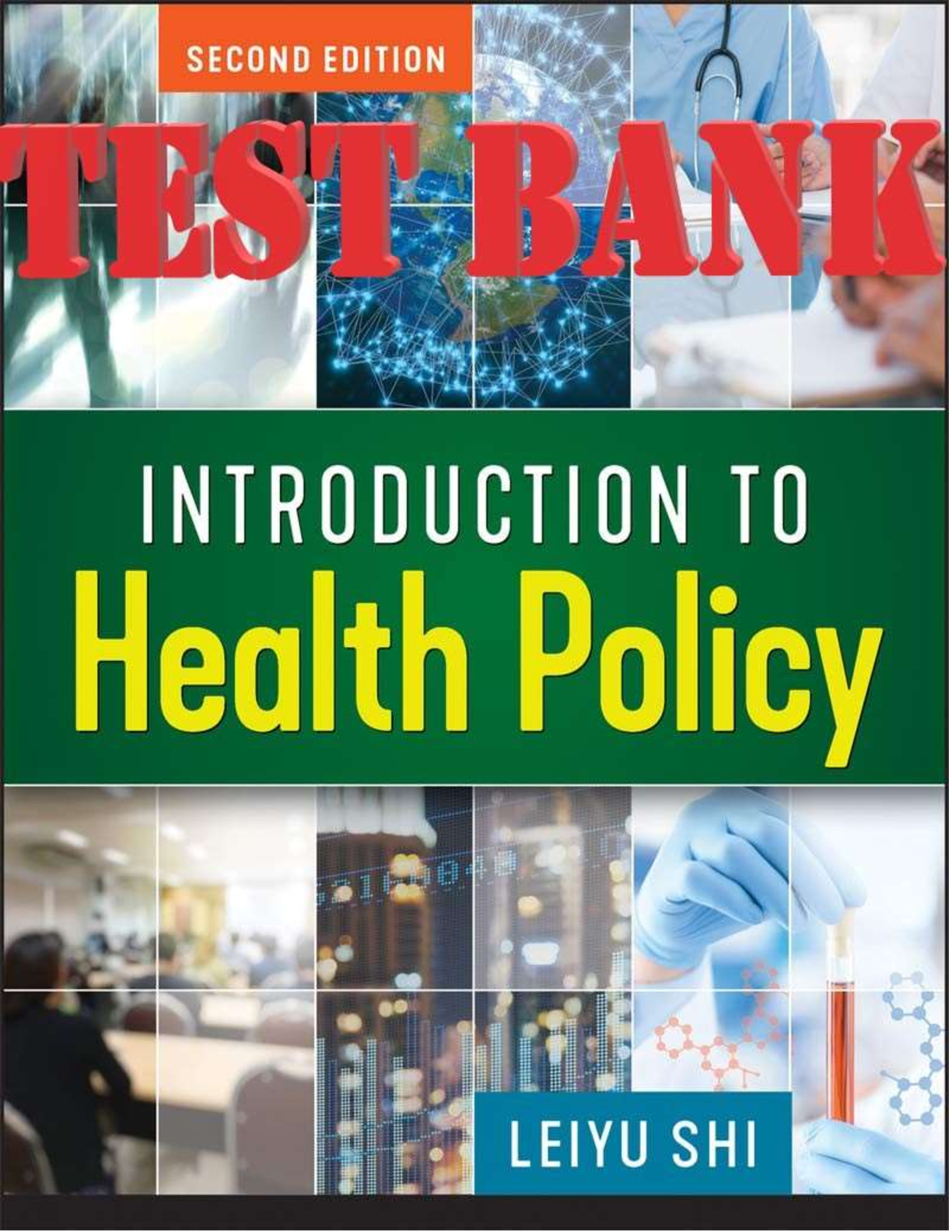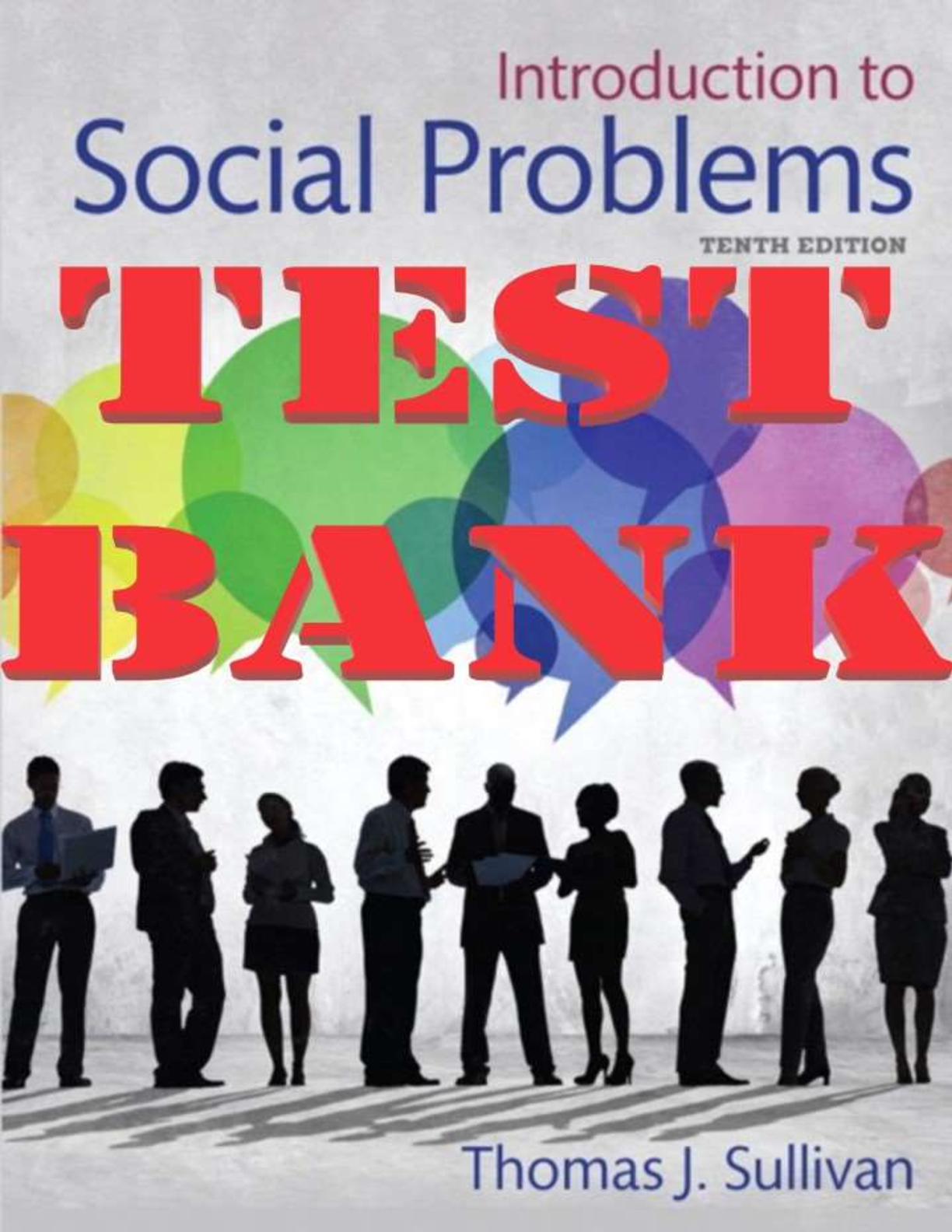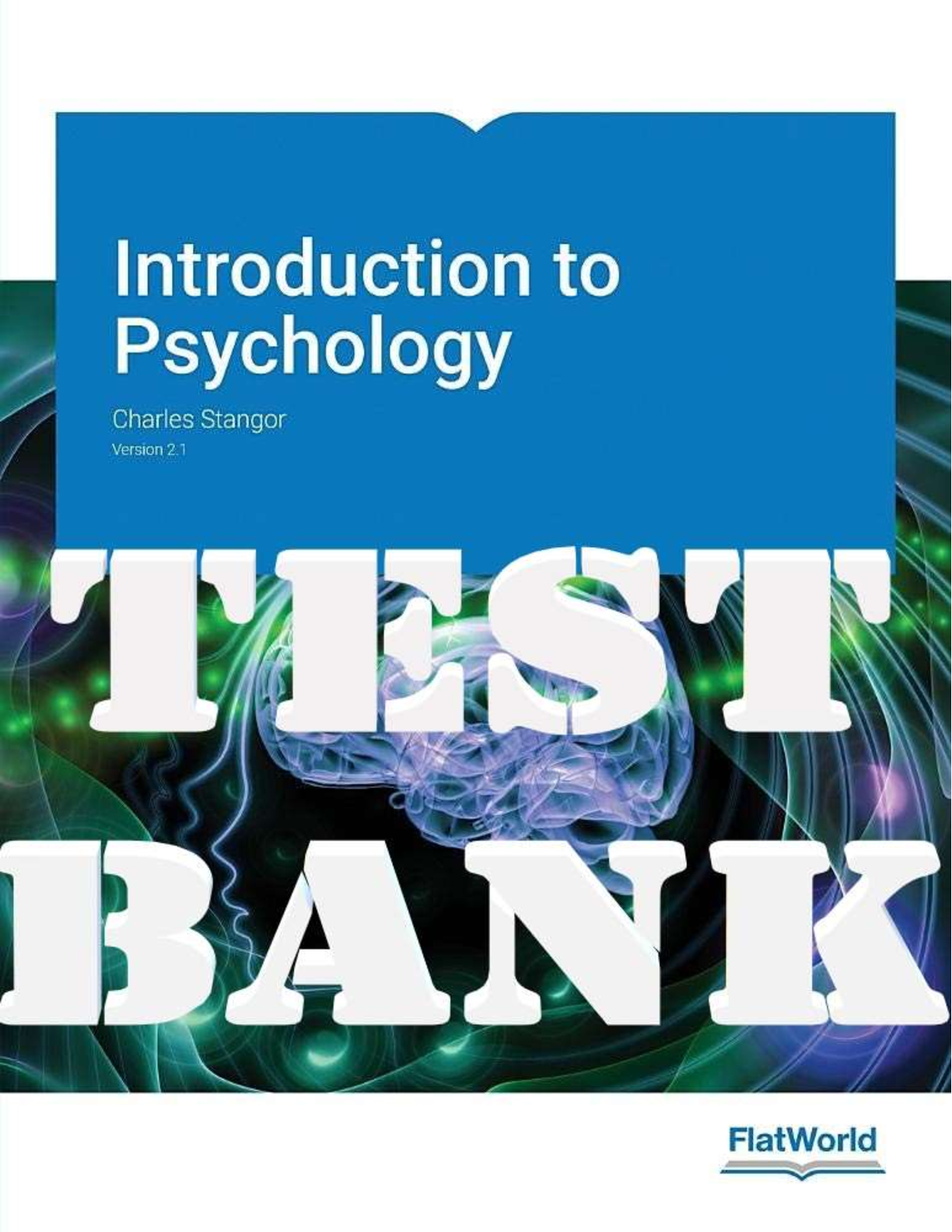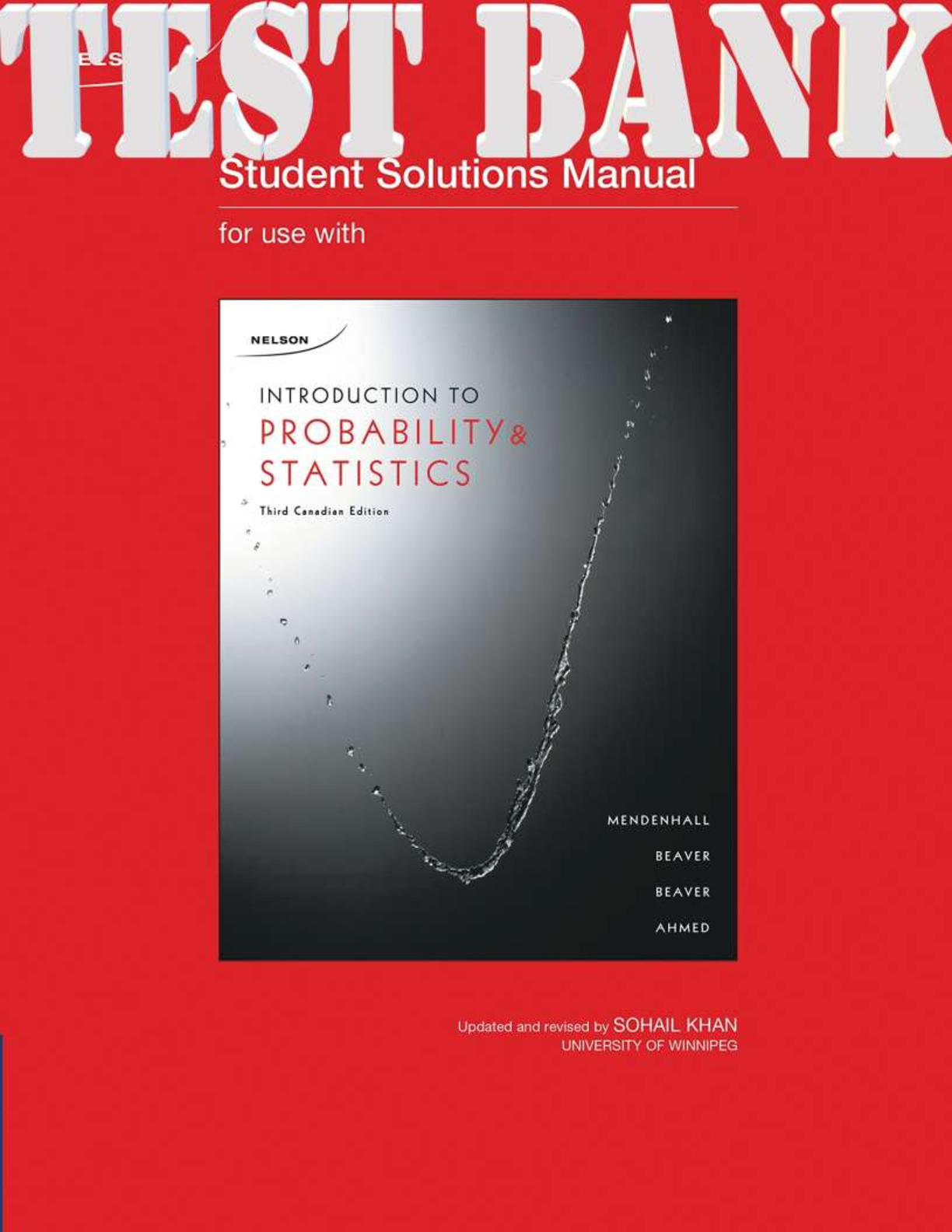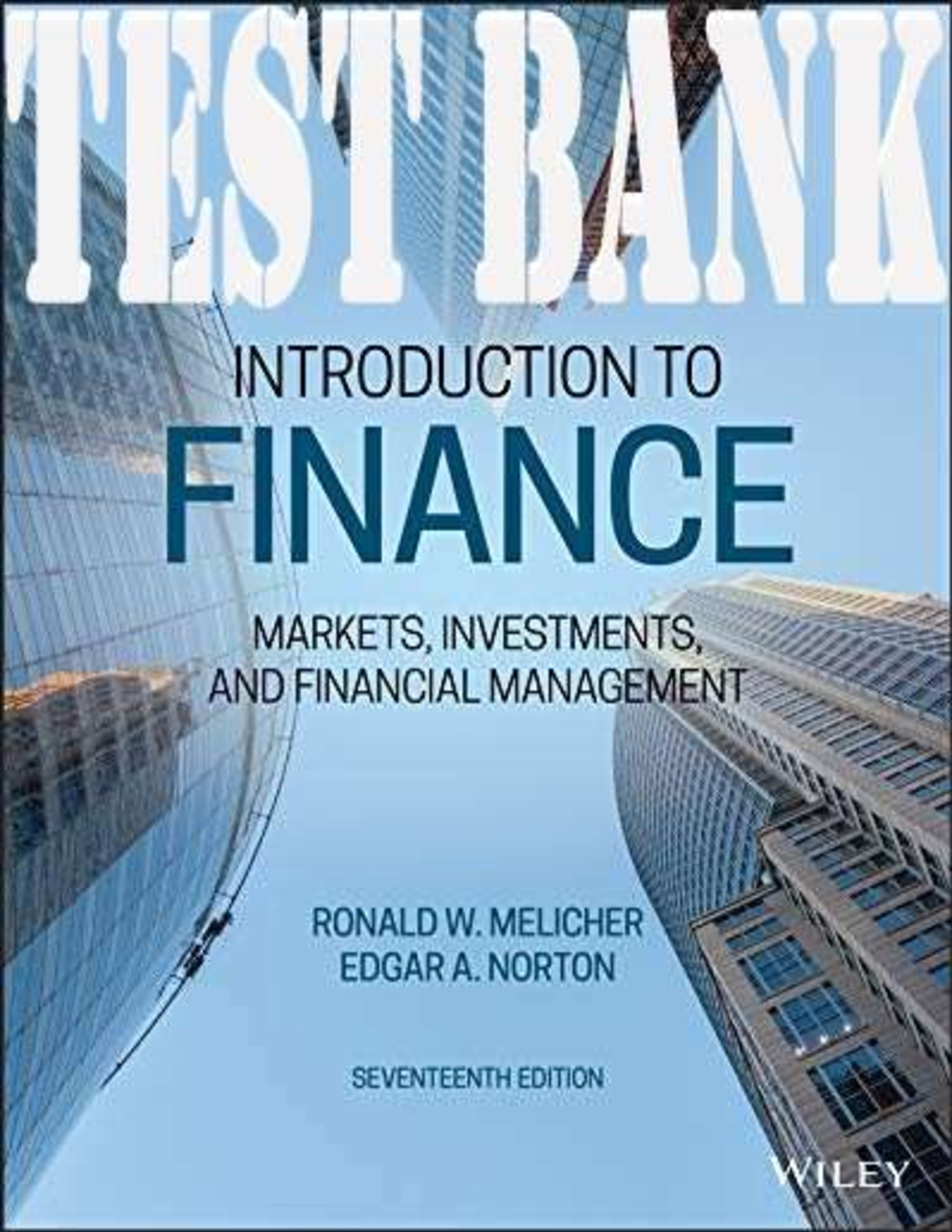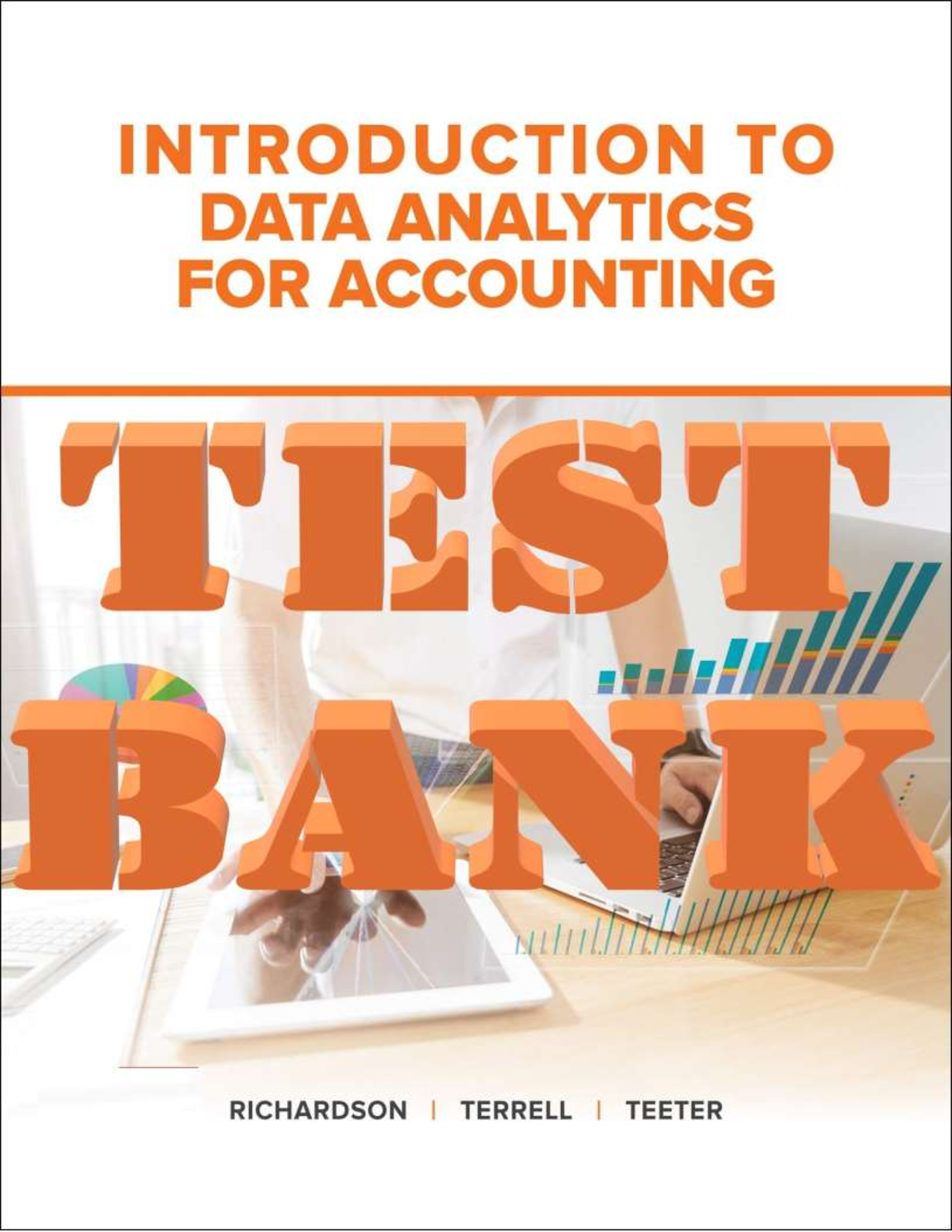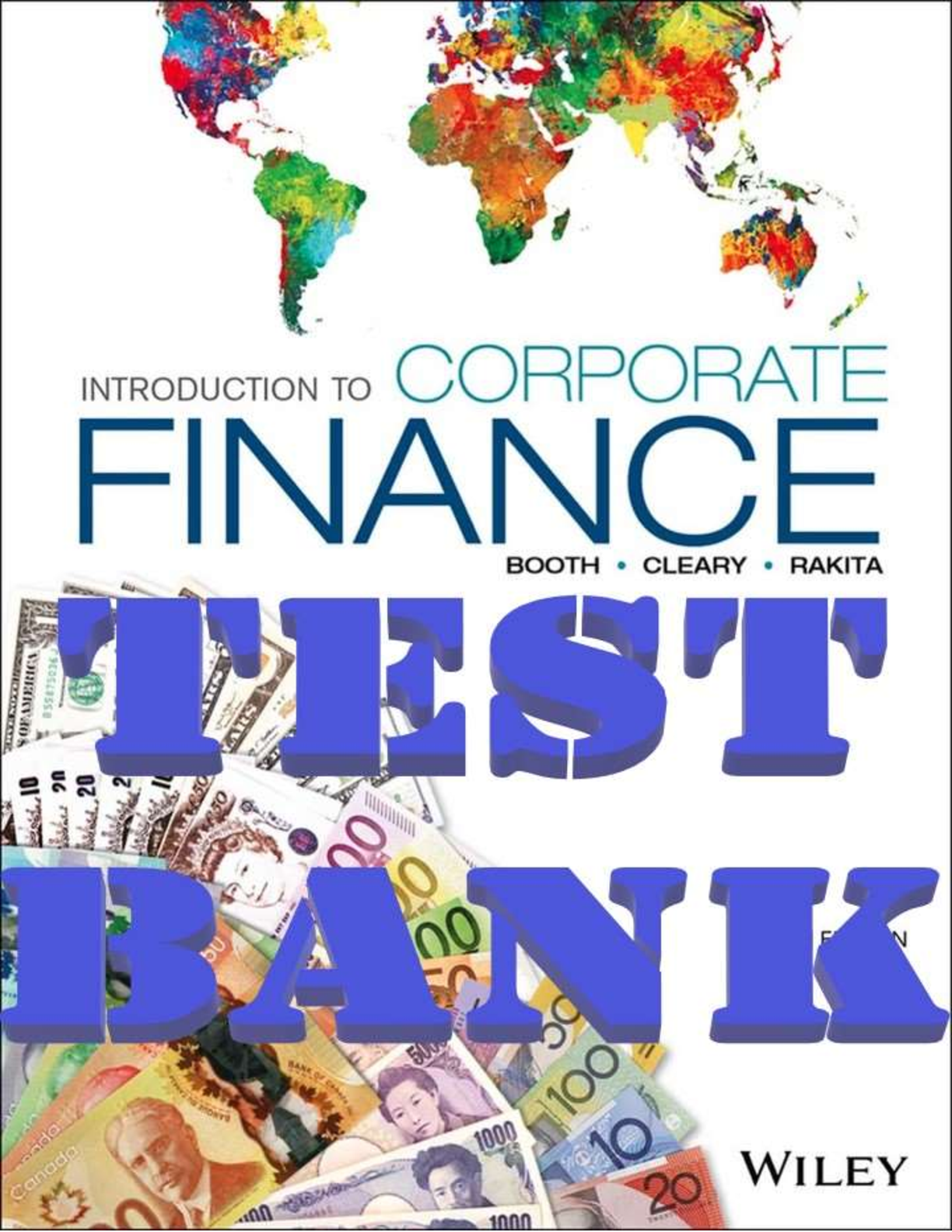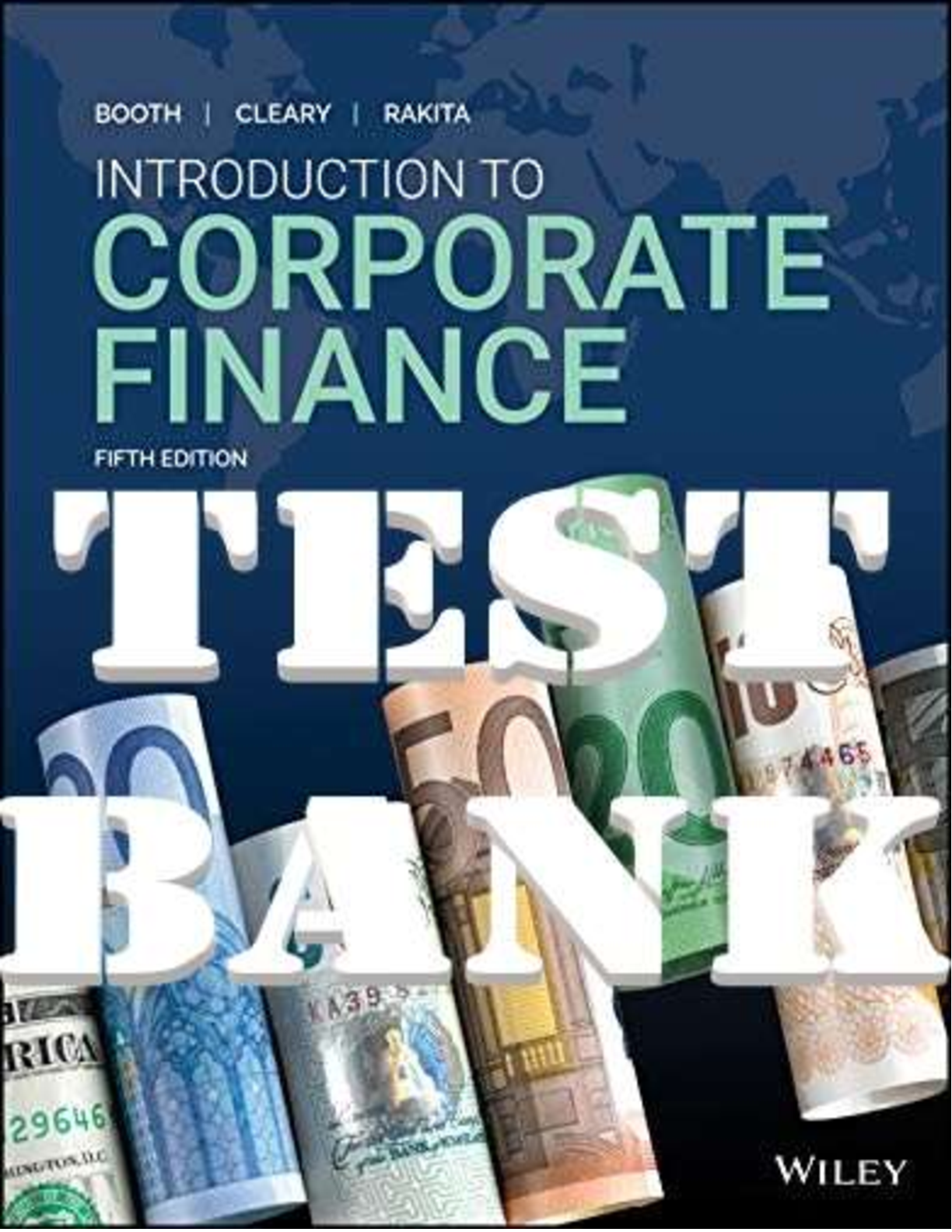Business Management > TEST BANK > Test Bank for Introduction to Management Science, 13th Edition by Taylor (All)
Test Bank for Introduction to Management Science, 13th Edition by Taylor
Document Content and Description Below
Introduction to Management Science, 13e (Taylor) Chapter 2 Linear Programming: Model Formulation and Graphical Solution 1) Linear programming is a model consisting of linear relationships repr... esenting a firm's decisions given an objective and resource constraints. Answer: TRUE Diff: 2 Page Ref: 34 Section Heading: Model Formulation Keywords: model formulation AACSB: Analytical thinking 2) The objective function always consists of either maximizing or minimizing some value. Answer: TRUE Diff: 2 Page Ref: 34 Section Heading: Model Formulation Keywords: objective function AACSB: Analytical thinking 3) The objective function is a linear relationship reflecting the objective of an operation. Answer: TRUE Diff: 1 Page Ref: 34 Section Heading: Model Formulation Keywords: model formulation AACSB: Analytical thinking 4) Both objective functions and constraints contain parameters. Answer: TRUE Diff: 2 Page Ref: 34 Section Heading: Model Formulation Keywords: model formulation AACSB: Analytical thinking 5) Proportionality means the slope of a constraint is proportional to the slope of the objective function. Answer: FALSE Diff: 2 Page Ref: 59 Section Heading: Characteristics of Linear Programming Problems Keywords: properties of linear programming models, proportionality AACSB: Analytical thinking 6) The terms in the objective function or constraints are additive. Answer: TRUE Diff: 2 Page Ref: 59 Section Heading: Characteristics of Linear Programming Problems Keywords: properties of linear programming models, additive AACSB: Analytical thinking 7) The terms in the objective function or constraints are multiplicative. Answer: FALSE Diff: 2 Page Ref: 59 Section Heading: Characteristics of Linear Programming Problems Keywords: properties of linear programming models, additive AACSB: Analytical thinking 8) All linear programming models exhibit a set of constraints. Answer: TRUE Diff: 1 Page Ref: 34 Section Heading: Model Formulation Keywords: properties of linear programming models, constraints AACSB: Analytical thinking 9) When using the graphical method, only one of the four quadrants of an xy-axis needs to be drawn. Answer: TRUE Diff: 1 Page Ref: 39 Section Heading: Graphical Solutions of Linear Programming Models Keywords: graphical linear programming AACSB: Analytical thinking 10) Linear programming models exhibit linearity among all constraint relationships and the objective function. Answer: TRUE Diff: 1 Page Ref: 59 Section Heading: Characteristics of Linear Programming Problems Keywords: properties of linear prog models, linearity, proportionality AACSB: Analytical thinking 11) The equation 8xy = 32 satisfies the proportionality property of linear programming. Answer: FALSE Diff: 2 Page Ref: 59 Section Heading: Characteristics of Linear Programming Problems Keywords: graphical solution, proportionality AACSB: Analytical thinking 12) Typically, finding a corner point for the feasible region involves solving a set of three simultaneous equations. Answer: FALSE Diff: 2 Page Ref: 45 Section Heading: Graphical Solutions of Linear Programming Models Keywords: graphical solution, extreme points, feasible region AACSB: Analytical thinking 13) Objective functions in linear programs always minimize costs. Answer: FALSE Diff: 2 Page Ref: 34 Section Heading: Model Formulation Keywords: properties of linear programming models, objective function AACSB: Analytical thinking 14) The feasible solution area contains infinite solutions to the linear program. Answer: TRUE Diff: 1 Page Ref: 41 Section Heading: Graphical Solutions of Linear Programming Models Keywords: properties of linear programming models, feasible solution area AACSB: Analytical thinking 15) There is exactly one optimal solution point to a linear program. Answer: FALSE Diff: 2 Page Ref: 57 Section Heading: Irregular Types of Linear Programming Problems Keywords: properties of linear programming models, optimal solution point AACSB: Analytical thinking 16) The following equation represents a resource constraint for a maximization problem: X + Y ≥ 20. Answer: FALSE Diff: 2 Page Ref: 36 Section Heading: A Maximization Model Example Keywords: properties of linear programming models, constraints AACSB: Analytical thinking 17) The optimal solution for a graphical linear programming problem is the corner point that is the farthest from the origin. Answer: FALSE Diff: 2 Page Ref: 42 Section Heading: Graphical Solutions of Linear Programming Models Keywords: feasibility, constraints AACSB: Analytical thinking 18) A minimization model of a linear program contains only surplus variables. Answer: FALSE Diff: 1 Page Ref: 55 Section Heading: A Minimization Model Example Keywords: properties of linear programming models, surplus variables AACSB: Analytical thinking 19) In the graphical approach, simultaneous equations may be used to solve for the optimal solution point. Answer: TRUE Diff: 2 Page Ref: 45 Section Heading: Graphical Solutions of Linear Programming Models Keywords: graphical solution AACSB: Analytical thinking 20) Slack variables are only associated with maximization problems. Answer: FALSE Diff: 2 Page Ref: 47 Section Heading: Graphical Solutions of Linear Programming Models Keywords: graphical solution, slack variables AACSB: Analytical thinking 21) Surplus variables are only associated with minimization problems. Answer: FALSE Diff: 2 Page Ref: 55 Section Heading: A Minimization Model Example Keywords: graphical solution, surplus variable AACSB: Analytical thinking 22) If the objective function is parallel to a constraint, the constraint is infeasible. Answer: FALSE Diff: 2 Page Ref: 57 Section Heading: Irregular Types of Linear Programming Problems Keywords: graphical solution AACSB: Analytical thinking 23) Multiple optimal solutions occur when constraints are parallel to each other. Answer: FALSE Diff: 2 Page Ref: 57 Section Heading: Irregular Types of Linear Programming Problems Keywords: graphical solution AACSB: Analytical thinking 24) Graphical solutions to linear programming problems have an infinite number of possible objective function lines. Answer: TRUE Diff: 2 Page Ref: 42 Section Heading: Graphical Solutions of Linear Programming Models Keywords: graphical solution, objective function line AACSB: Analytical thinking 25) The first step in formulating a linear programming model is to define the objective function. Answer: FALSE Diff: 2 Page Ref: 34 Section Heading: Introduction Keywords: linear programming problems, formulation AACSB: Analytical thinking 26) A linear programming problem requires a choice between alternative courses of action. Answer: TRUE Diff: 2 Page Ref: 59 Section Heading: Characteristics of Linear Programming Problems Keywords: linear programming problems, formulation AACSB: Application of knowledge 27) The term continuous is synonymous with divisible in the context of linear programming. Answer: TRUE Diff: 2 Page Ref: 59 Section Heading: Characteristics of Linear Programming Problems Keywords: linear programming problems, formulation AACSB: Application of knowledge 28) Linear programming problems can model decreasing marginal returns. Answer: FALSE Diff: 2 Page Ref: 59 Section Heading: Characteristics of Linear Programming Problems Keywords: linear programming problems, formulation AACSB: Application of knowledge 29) One of the most frequent objectives of business forms is to gain the most profit possible. Answer: TRUE Diff: 1 Page Ref: 36 Section Heading: Introduction Keywords: linear programming problems, maximization AACSB: Analytical thinking 30) We have George Dantzig to thank for developing linear programming. Answer: TRUE Diff: 2 Page Ref: 37 Section Heading: A Maximization Model Example Keywords: linear programming, Dantzig AACSB: Analytical thinking 31) In the absence of nonnegativity constraints, our solution cannot have zero values for decision variables. Answer: FALSE Diff: 2 Page Ref: 37 Section Heading: A Maximization Model Example Keywords: nonnegativity, linear programming AACSB: Analytical thinking 32) If there are no feasible solutions to a linear programming model, then the best course of action for a manager is to choose a solution that violates at least one constraint. Answer: FALSE Diff: 1 Page Ref: 41 Section Heading: Graphical Solutions of Linear Programming Models Keywords: properties of linear programming models, feasible solution area AACSB: Analytical thinking 33) ________ are mathematical symbols representing levels of activity. Answer: Decision variables Diff: 1 Page Ref: 34 Section Heading: Model Formulation Keywords: decision variables, model formulation AACSB: Analytical thinking 34) A(n) ________ is a linear relationship representing a restriction on decision making. Answer: constraint Diff: 1 Page Ref: 34 Section Heading: Model Formulation Keywords: constraint, model formulation AACSB: Analytical thinking 35) If at least one constraint in a linear programming model is violated, the solution is said to be ________. Answer: infeasible Diff: 1 Page Ref: 57 Section Heading: Irregular Types of Linear Programming Problems Keywords: constraint, infeasible solution AACSB: Analytical thinking 36) A graphical solution is limited to solving linear programming problems with ________ decision variables. Answer: two Diff: 1 Page Ref: 38 Section Heading: Graphical Solutions of Linear Programming Models Keywords: graphical solution AACSB: Analytical thinking 37) The ________ solution area is an area bounded by the constraint equations. Answer: feasible Diff: 1 Page Ref: 41 Section Heading: Graphical Solutions of Linear Programming Models Keywords: graphical solution AACSB: Analytical thinking 38) Multiple optimal solutions can occur when the objective function line is ________ to a constraint line. Answer: parallel Diff: 2 Page Ref: 47 Section Heading: Graphical Solutions of Linear Programming Models Keywords: graphical solution, multiple optimal solutions AACSB: Analytical thinking 39) XY Corporation makes two products, X and Y, and uses graphical linear programming to determine their monthly product mix. This November, their only production constraint is X ≤ 75. November's production problem is ________. Answer: unbounded Diff: 2 Page Ref: 58 Section Heading: Irregular Types of Linear Programming Problems Keywords: graphical solution, unbounded problem AACSB: Analytical thinking 40) The best feasible solution is ________. Answer: optimal Diff: 1 Page Ref: 43 Section Heading: Graphical Solutions of Linear Programming Models Keywords: optimal solutions AACSB: Analytical thinking 41) In a constraint, the ________ variable represents unused resources. Answer: slack Diff: 1 Page Ref: 47 Section Heading: Graphical Solutions of Linear Programming Models Keywords: graphical solution, surplus variable AACSB: Analytical thinking 42) ________ is the difference between the left- and right-hand sides of a greater than or equal to constraint. Answer: Surplus Diff: 1 Page Ref: 55 Section Heading: A Minimization Model Example Keywords: surplus AACSB: Analytical thinking 43) If the objective function is parallel to a constraint, the linear program could have ________. Answer: multiple optimal solutions Diff: 2 Page Ref: 47 Section Heading: Graphical Solutions of Linear Programming Models Keywords: graphical solutions, multiple optimal solutions AACSB: Analytical thinking 44) Corner points on the boundary of the feasible solution area are called ________ points. Answer: extreme Diff: 1 Page Ref: 44 Section Heading: Graphical Solutions of Linear Programming Models Keywords: feasibility, constraints AACSB: Analytical thinking 45) ________ are at the endpoints of the constraint line segment that the objective function parallels. Answer: Alternate optimal solutions Diff: 3 Page Ref: 57 Section Heading: Irregular Types of Linear Programming Problems Keywords: alternative optimal solutions, multiple optimal solutions AACSB: Analytical thinking 46) The ________ step in formulating a linear programming model is to define the decision variables. Answer: first Diff: 1 Page Ref: 36 Section Heading: A Maximization Model Example Keywords: linear programming, formulation AACSB: Analytical thinking 47) The management scientist constructed a linear program to help the alchemist maximize his gold production process. The computer model chugged away for a few minutes and returned an answer of infinite profit., which is what might be expected from a(n) ________ problem. Answer: unbounded Diff: 1 Page Ref: 58 Section Heading: Irregular Types of Linear Programming Problems Keywords: unbounded AACSB: Analytical thinking 48) The ________ property of linear programming models indicates that the rate of change, or slope, of the objective function or a constraint is constant. Answer: proportionality or linearity Diff: 2 Page Ref: 59 Section Heading: Characteristics of Linear Programming Problems Keywords: properties of linear programming models, certainty AACSB: Analytical thinking 49) The objective function 3x + 2y + 4xy violates the assumption of ________. Answer: additivity Diff: 2 Page Ref: 59 Section Heading: Characteristics of Linear Programming Problems Keywords: linear programming properties AACSB: Application of knowledge 50) Mildred is attempting to prepare an optimal quantity of macaroni and cheese for the potluck supper this Sunday. The instructions indicate that one cup of water is needed for each box she needs to prepare. She sleeps well on Saturday night, secure in her knowledge that she knows the precise amount of water she will need the next day. This knowledge illustrates the assumption of ________. Answer: certainty Diff: 2 Page Ref: 59 Section Heading: Characteristics of Linear Programming Problems Keywords: linear programming properties AACSB: Application of knowledge 51) Tim! airlines procurement division works with their linear programming algorithm to secure contracts for gasoline for the coming year. After twenty minutes of thinking, the computer suggests that they secure 425.8125 contracts with their suppliers. This value illustrates the assumption of ________ in linear programming models. Answer: divisibility or continuous Diff: 2 Page Ref: 59 Section Heading: Characteristics of Linear Programming Problems Keywords: linear programming properties AACSB: Application of knowledge 52) In a linear programming problem, the binding constraints for the optimal solution are: 5x1 + 3x2 ≤ 30 2x1 + 5x2 ≤ 20 As long as the slope of the objective function stays between ________ and ________, the current optimal solution point will remain optimal. Answer: -5/3, -2/5 Diff: 3 Page Ref: 41 Section Heading: Graphical Solutions of Linear Programming Models Keywords: optimal solution, solution interpretation, slope AACSB: Analytical thinking 53) In a graphical approach to a linear programming problem, the objective function is represented by a(n) ________. Answer: (straight) line Diff: 2 Page Ref: 42 Section Heading: Graphical Solutions of Linear Programming Models Keywords: optimal solution, solution interpretation, slope AACSB: Analytical thinking 54) In a graphical approach to a linear programming problem, the objective function has a maximum value when it is ________ the origin. Answer: farthest away from Diff: 2 Page Ref: 45 Section Heading: Graphical Solutions of Linear Programming Models Keywords: optimal solution, solution interpretation, slope AACSB: Analytical thinking 55) The three types of linear programming constraints are ________, ________, and ________. Answer: ≥, ≤, = (greater than or equal to, less than or equal to, equal to) Diff: 1 Page Ref: 52 Section Heading: A Minimization Model Example Keywords: linear programming, constraint AACSB: Analytical thinking 56) In a linear programming problem, the binding constraints for the optimal solution are: 5x1 + 3x2 ≤ 30 2x1 + 5x2 ≤ 20 Which of these objective functions will lead to the same optimal solution? A) 2x1 + 1x2 B) 7x1 + 8x2 C) 80x1 + 60x2 D) 25x1 + 15x2 Answer: D Diff: 3 Page Ref: 42 Section Heading: Graphical Solutions of Linear Programming Models Keywords: optimal solution, solution interpretation, slope AACSB: Analytical thinking 57) Decision variables: A) measure the objective function. B) measure how much or how many items to produce, purchase, hire, etc. C) always exist for each constraint. D) measure the values of each constraint. Answer: B Diff: 2 Page Ref: 34 Section Heading: Model Formulation Keywords: decision variables AACSB: Analytical thinking 58) In a linear programming problem, a valid objective function can be represented as: A) Max Z = 5xy B) Max Z 5x2 + 2y2 C) Max 3x + 3y + 1/3 z D) Min (x1 + x2) / x3 Answer: C Diff: 3 Page Ref: 59 Section Heading: Characteristics of Linear Programming Problems Keywords: objective function AACSB: Analytical thinking 59) Which of the following could not be a linear programming problem constraint? A) 1A + 2B ≠ 3 B) 1A + 2B = 3 C) 1A + 2B ≤ 3 D) 1A + 2B ≥ 3 Answer: A Diff: 2 Page Ref: 36 Section Heading: A Maximization Model Example Keywords: formulation, constraints AACSB: Analytical thinking 60) Which of the following could be a linear programming objective function? A) Z = 1A + 2BC + 3D B) Z = 1A + 2B + 3C + 4D C) Z = 1A + 2B / C + 3D D) Z = 1A + 2B2 + 3D Answer: B Diff: 2 Page Ref: 59 Section Heading: Characteristics of Linear Programming Problems Keywords: objective function AACSB: Analytical thinking The campaign manager for a doomed candidate is considering the which states to visit during the last frenzied campaign week leading up to the nationwide election. Pennsylvania (P), Wisconsin (W), Florida (F), New York (Y), and North Carolina (C) are all aching for one last visit, but the candidate has only 80 hours and $250 million left in her campaign fund. A visit to Pennsylvania takes 10 hours and costs $15 million but earns 1% of the electorate. A visit to Wisconsin takes 15 hours and costs $20 million and earns 1.5%; a visit to Florida is only $8 million but takes 16 hours and earns 2%, and a visit to New York costs $25 million, requires 2 hours and earns 2% of the electorate. North Carolina requires 18 hours and $22 million per trip but earns 3% of the electorate. 61) What is the objective function? A) MIN 10P+15W+16F+2Y+18C B) MAX 10P+15W+16F+2Y+18C C) MIN 15P+20W+8F+25Y+22C D) MAX P+1.5W+2F+2Y+3C Answer: D Diff: 2 Page Ref: 36 Section Heading: A Maximization Model Example Keywords: formulation, objective function AACSB: Analytical thinking D) 15P+20W+8F+25Y+22C ≤ 80 Answer: C Diff: 2 Page Ref: 36 Section Heading: A Maximization Model Example Keywords: formulation, constraints AACSB: Analytical thinking 63) What is the financial constraint? A) P+1.5W+2F+2Y+3C ≤ 250 B) 15P+20W+8F+25Y+22C ≤ 250 C) 15P+20W+8F+25Y+22C ≤ 80 D) 10P+15W+16F+2Y+18C ≤ 250 Answer: B Diff: 2 Page Ref: 36 Section Heading: A Maximization Model Example Keywords: formulation, constraints AACSB: Analytical thinking 64) The ________ property of linear programming models indicates that the rate of change or slope of the objective function or a constraint is constant. A) additive B) divisibility C) certainty D) proportionality Answer: D Diff: 2 Page Ref: 59 Section Heading: Characteristics of Linear Programming Problems Keywords: properties of linear programming models AACSB: Analytical thinking 65) The ________ property of linear programming models indicates that the values of all the model parameters are known and are assumed to be constant. A) additive B) divisibility C) certainty D) proportionality Answer: C Diff: 2 Page Ref: 59 Section Heading: Characteristics of Linear Programming Problems Keywords: properties of linear programming models AACSB: Analytical thinking 66) The region that satisfies all of the constraints in a graphical linear programming problem is called the: A) region of optimality. B) feasible solution space. C) region of non-negativity. D) optimal solution space. Answer: B Diff: 1 Page Ref: 41 Section Heading: Graphical Solutions of Linear Programming Models Keywords: graphical solution, feasibility AACSB: Analytical thinking 67) In the formulation of a ≥ constraint: A) a surplus variable is subtracted. B) a surplus variable is added. C) a slack variable is subtracted. D) a slack variable is added. Answer: A Diff: 1 Page Ref: 55 Section Heading: A Minimization Model Example Keywords: surplus AACSB: Analytical thinking 68) Which of the following statements is not true? A) An infeasible solution violates all constraints. B) A feasible solution point does not have to lie on the boundary of the feasible solution. C) A feasible solution satisfies all constraints. D) An optimal solution satisfies all constraints. Answer: A Diff: 2 Page Ref: 41 Section Heading: Graphical Solutions of Linear Programming Models Keywords: graphical solution, feasibility AACSB: Analytical thinking 69) A hot dog manufacturer wishes to minimize the cost in dollars of producing a low-cost niched product while meeting the dietary guidelines for protein and sodium. Once the model has been run, the surplus variable in the sodium constraint has a value of 1300 milligrams. The best interpretation of this outcome is: A) the value of the sodium in a hot dog is 1300. B) the amount of sodium in a single hot dog should be 1300 milligrams. C) the minimum cost hot dog has 1300 milligrams more sodium than required. D) a hot dog should have at least 1300 milligrams of sodium. Answer: C Diff: 2 Page Ref: 55 Section Heading: A Minimization Model Example Keywords: surplus AACSB: Analytical thinking 70) Which of these statements is best? A) An unbounded problem is also infeasible. B) An infeasible problem is also unbounded. C) An unbounded problem has feasible solutions. D) An infeasible problem has unbounded solutions. Answer: C Diff: 2 Page Ref: 58 Section Heading: Irregular Types of Linear Programming Problems Keywords: infeasible problem, infeasible solution AACSB: Analytical thinking 71) The optimal solution to a linear programming model that has been solved using the graphical approach: A) is typically located at the origin. B) must be below and on the left side of all constraint lines. C) must be above and the right of all constraint lines. D) is typically at some corner of the feasible region. Answer: D Diff: 1 Page Ref: 42 Section Heading: Graphical Solutions of Linear Programming Models Keywords: solution AACSB: Analytical thinking 72) Without satisfying the non-negativity constraint, a solution that satisfies all the other constraints of a linear programming problem is called: A) feasible. B) infeasible. C) semi-feasible. D) optimal. Answer: B Diff: 3 Page Ref: 41 Section Heading: Graphical Solutions of Linear Programming Models Keywords: graphical solution, feasibility AACSB: Analytical thinking 73) An intern sets up a linear program to optimize the use of paper products in the men's washroom. The system of equations he develops is: Max 2T + 3S + 4ST s.t 3T + 6S ≤ 40 10T + 10S ≤ 66 10T + 15S ≤ 99 His mentor studies the model, frowns, and admonishes the intern for violating which of the following properties of linear programming models? A) divisibility B) proportionality C) certainty D) additivity Answer: D Diff: 1 Page Ref: 59 Section Heading: Characteristics of Linear Programming Problems Keywords: additivity AACSB: Analytical thinking 74) Which of the following is not a typical characteristic of a linear programming problem? A) Restrictions exist. B) A choice among alternatives is required. C) The problem can be solved graphically. D) The problem has an objective. Answer: C Diff: 1 Page Ref: 59 Section Heading: Characteristics of Linear Programming Problems Keywords: graphical solution AACSB: Analytical thinking The campaign manager for a doomed candidate is considering the which states to visit during the last frenzied campaign week leading up to the nationwide election. Pennsylvania (P), Wisconsin (W), Florida (F), New York (Y), and North Carolina (C) are all aching for one last visit, but the candidate has only 80 hours and $250 million left in her campaign fund. A visit to Pennsylvania takes 10 hours and costs $15 million but earns 1% of the electorate. A visit to Wisconsin takes 15 hours and costs $20 million and earns 1.5%; a visit to Florida is only $8 million but takes 16 hours and earns 2%, and a visit to New York costs $25 million, requires 2 hours and earns 2% of the electorate. North Carolina requires 18 hours and $22 million per trip but earns 3% of the electorate. 75) Which of the following is not a feasible schedule? A) two trips each to Pennsylvania and Wisconsin and one trip each to Florida, New York, and North Carolina B) four trips each to New York and North Carolina C) two trips each to Pennsylvania and North Carolina and one trip to Florida D) four trips to Wisconsin and five trips to New York Answer: A Diff: 3 Page Ref: 41 Section Heading: Graphical Solutions of Linear Programming Models Keywords: graphical solution, feasibility AACSB: Analytical thinking 76) What is the total percentage increase if the candidate makes the following schedule? A) 10% B) 11% C) 12% D) 13% Answer: D Diff: 2 Page Ref: 44 Section Heading: Graphical Solutions of Linear Programming Models Keywords: graphical solution AACSB: Analytical thinking 77) ________ is used to analyze changes in model parameters. A) Optimal solution B) Feasible solution C) Sensitivity analysis D) A slack variable Answer: C Diff: 2 Page Ref: 47 Section Heading: Graphical Solutions of Linear Programming Models Keywords: sensitivity analysis AACSB: Analytical thinking Lame Example Furniture Company makes two products for its adoring public: chairs (C)and tables (T). Each chair requires 5 hours of labor (L) and 4 linear feet of rich mahogany (M), and each table requires 3 hours of labor and 20 linear feet of rich mahogany. The company has 240 labor hours available this week, and the warehouse has 700 linear feet of rich mahogany available. Profit for each chair is $300 and for each table is $1500. 78) Which of the following is not a feasible production plan? A) 35 chairs and 20 tables B) 20 chairs and 35 tables C) 25 chairs and 30 tables D) 30 chairs and 25 tables Answer: B Diff: 3 Page Ref: 41 Section Heading: Graphical Solutions of Linear Programming Models Keywords: formulation, feasibility AACSB: Analytical thinking 79) What is the maximum profit? A) $52,500 B) $48,000 C) $55,000 D) $56,250 Answer: A Diff: 3 Page Ref: 43 Section Heading: Graphical Solutions of Linear Programming Models Keywords: graphical solution AACSB: Analytical thinking 80) In order to maximize profit, how many tables and how many chairs should be produced? A) T = 35, C = 0 B) T = 0, C = 48 C) T = 26.3, C = 32.8 D) T = 28.9, C = 30.7 Answer: A Diff: 3 Page Ref: 43 Section Heading: Graphical Solutions of Linear Programming Models Keywords: graphical solution AACSB: Analytical thinking 81) The theoretical limit on the number of constraints that can be handled by a linear programming problem is: A) 2. B) 3. C) 4. D) unlimited. Answer: D Diff: 1 Page Ref: 34 Section Heading: Model Formulation Keywords: constraints AACSB: Analytical thinking 82) Consider the following maximization problem. MAX z = x + 2y s.t. The optimal solution: A) occurs where x = 4.67 and y = 1.11. B) occurs where x = 0 and y = 2. C) occurs where x = 6 and y = 0. D) results in an objective function value of 12. Answer: B Diff: 1 Page Ref: 44 Section Heading: Graphical Solutions of Linear Programming Models Keywords: graphical solution, extreme points, feasible region AACSB: Analytical thinking Figure 1: The following is a graph of a linear programming problem. The feasible solution space is shaded, and the optimal solution is at the point labeled Z*. 83) This linear programming problem shown in Figure 1 is a(n): A) maximization problem. B) minimization problem. C) irregular problem. D) cannot tell from the information given Answer: B Diff: 1 Page Ref: 52 Section Heading: A Minimization Model Example Keywords: graphical solution AACSB: Analytical thinking 84) The equation for constraint DH as shown in Figure 1 is: A) 4X + 8Y ≥ 32. Diff: 3 Page Ref: 52 Section Heading: A Minimization Model Example Keywords: graphical solution, constraints AACSB: Analytical thinking 85) Which of the following points is not feasible for the graph shown in Figure 1? A) A B) B C) H D) G Answer: D Diff: 1 Page Ref: 41 Section Heading: Graphical Solutions of Linear Programming Models Keywords: graphical solution, feasible point AACSB: Analytical thinking 86) Which line in Figure 1 is represented by the equation 2X + Y ≥ 8? A) BF B) CG C) DH D) AJ Answer: A Diff: 2 Page Ref: 41 Section Heading: Graphical Solutions of Linear Programming Models Keywords: graphical solution, constraints AACSB: Analytical thinking 87) Which of the following constraints shown in Figure 1 has a surplus greater than 0? A) BF B) CG C) DH D) AJ Answer: C Diff: 2 Page Ref: 55 Section Heading: A Minimization Model Example Keywords: graphical solution, constraints AACSB: Analytical thinking 88) In Figure 1, the constraint AJ: A) is a binding constraint. B) has no surplus. C) does not contain feasible points. D) contains the optimal solution. Answer: B Diff: 3 Page Ref: 55 Section Heading: A Minimization Model Example Keywords: graphical solution, constraints AACSB: Analytical thinking Figure 2 89) Consider the optimization problem represented by the graph in Figure 2. Which of the following statements is best? A) This is a maximization problem with a feasible solution. B) This is a maximization problem with no feasible solution. C) This is a minimization problem with a feasible solution. D) This is a minimization problem with no feasible solution. Answer: C Diff: 1 Page Ref: 56 Section Heading: A Minimization Model Example Keywords: graphical solution, feasibility AACSB: Analytical thinking 90) Line segment GH in Figure 2 represents the objective function. Which constraint has surplus? A) AB B) CD C) EF D) none of the constraints has surplus Answer: A Diff: 2 Page Ref: 55 Section Heading: A Minimization Model Example Keywords: graphical solution, surplus variable AACSB: Analytical thinking 91) What is the equation for the constraint AB shown in Figure 2? A) 3X + 12Y ≥ 15 Answer: D Diff: 3 Page Ref: 53 Section Heading: A Minimization Model Example Keywords: graphical solution, constraints AACSB: Analytical thinking 92) What is the equation for constraint EF shown in Figure 2? A) 4X + 8Y ≥ 64 D) 16X + 8Y ≥ 32 Answer: A Diff: 3 Page Ref: 53 Section Heading: A Minimization Model Example Keywords: graphical solution, constraints AACSB: Analytical thinking 93) Consider the optimization problem represented by the graph in Figure 2. The objective function is represented by line GH. Where is the optimal solution? A) the intersection of lines AB and EF B) the intersection of lines AB and CD C) the intersection of lines CD and EF D) the upper right corner of the shaded region Answer: C Diff: 1 Page Ref: 53 Section Heading: A Minimization Model Example Keywords: graphical solution, objective function line AACSB: Analytical thinking 94) Consider the optimization problem represented by the graph in Figure 2. Line GH represents the objective function. Which of the following statements is best? A) This is a single optimal solution. B) All points along GH are optimal. C) All points on lines AB, CD and DE that touch the shaded region are optimal. D) All points in the shaded region are optimal Answer: A Diff: 1 Page Ref: 53 Section Heading: A Minimization Model Example Keywords: graphical solution, multiple optimal solutions AACSB: Analytical thinking 95) In order for an optimization problem to have multiple optimal solutions: A) the objective function and one constraint must have the same y-intercept. B) the objective function and one constraint must have the same slope. C) two or more of the constraints must not have intersection points. D) two or more of the constraints must have the same slope. Answer: B Diff: 2 Page Ref: 57 Section Heading: Irregular Types of Linear Programming Problems Keywords: graphical solutions, multiple optimal solutions AACSB: Analytical thinking 96) An optimization problem that has multiple optimal solutions: A) means that there are actually no optimal solutions. B) is reflected by the entire feasible region being optimal C) means that the surplus for a third constraint cannot be calculated. D) provides the decision-maker with increased flexibility. Answer: D Diff: 2 Page Ref: 57 Section Heading: Irregular Types of Linear Programming Problems Keywords: graphical solutions, multiple optimal solutions AACSB: Analytical thinking 97) How would multiple optimal solutions typically appear on a graphical solution? A) a point B) a line C) a plane D) a cube Answer: B Diff: 2 Page Ref: 57 Section Heading: Irregular Types of Linear Programming Problems Keywords: graphical solutions, multiple optimal solutions AACSB: Analytical thinking 98) Which of the following statements about infeasible problems is best? A) All of the possible solutions violate at least one constraint. B) All of the possible solutions violate all of the constraints. C) At least one of the possible solutions violates all of the constraints. D) At least one of the possible solutions violates at least one of the constraints. Answer: A Diff: 1 Page Ref: 58 Section Heading: Irregular Types of Linear Programming Problems Keywords: infeasible problem, infeasible solution AACSB: Analytical thinking 99) Greg, a young entrepreneur, has developed an aggressive business plan and is presenting his profit projections on the popular show Shark Tank in hopes of securing some venture capital. He concludes his presentation with an LP model of his planned product mix, and is convinced he will seal the deal by demonstrating that his profits are limitless since his LP model is unbounded. What should the sharks tell him? A) "Limitless profits sound fantastic, here's a blank check." B) "Limitless profits are possible only in minimization models, and we want you to maximize profits." C) "Unlimited profits aren't possible. You must have made a mistake in your LP model." D) "Limitless profits are possible only in maximization models, and we want you to minimize profits." Answer: C Diff: 1 Page Ref: 58 Section Heading: Irregular Types of Linear Programming Problems Keywords: unbounded AACSB: Analytical thinking 100) Multiple optimal solutions can occur when the objective function is ________ a constraint line. A) unequal to B) equal to C) perpendicular to D) parallel to Answer: D Diff: 2 Page Ref: 57 Section Heading: Irregular Types of Linear Programming Problems Keywords: irregular types of linear programming problems AACSB: Analytical thinking han the right side. Answer: B Diff: 2 Page Ref: 46 Section Heading: Slack Variables Keywords: slack variables AACSB: Analytical thinking The campaign manager for a doomed candidate is considering the which states to visit during the last frenzied campaign week leading up to the nationwide election. Pennsylvania (P), Wisconsin (W), Florida (F), New York (Y), and North Carolina (C) are all aching for one last visit, but the candidate has only 80 hours and $250 million left in her campaign fund. A visit to Pennsylvania takes 10 hours and costs $15 million but earns 1% of the electorate. A visit to Wisconsin takes 15 hours and costs $20 million and earns 1.5%; a visit to Florida is only $8 million but takes 16 hours and earns 2%, and a visit to New York costs $25 million, requires 2 hours and earns 2% of the electorate. North Carolina requires 18 hours and $22 million per trip but earns 3% of the electorate. 102) The campaign manager elects to take one trip each of Pennsylvania, Florida and North Carolina, two trips to Wisconsin, and three trips to New York. Which resources will be completely used? A) only money B) only time C) time and money D) neither time nor money Answer: B Diff: 2 Page Ref: 48 Section Heading: Graphical Solutions of Linear Programming Models Keywords: slack variables AACSB: Analytical thinking Lame Example Furniture Company makes two products for its adoring public: chairs (C)and tables (T). Each chair requires 5 hours of labor (L) and 4 linear feet of rich mahogany (M), and each table requires 3 hours of labor and 20 linear feet of rich mahogany. The company has 240 labor hours available this week, and the warehouse has 700 linear feet of rich mahogany available. Profit for each chair is $300 and for each table is $1500. 103) If the furniture company produces twenty tables and thirty-six chairs, which of the two resources will be completely used? A) labor only B) rich mahogany only C) both labor and rich mahogany D) neither labor and rich mahogany Answer: A Diff: 2 Page Ref: 41 Section Heading: Graphical Solutions of Linear Programming Models Keywords: slack variables AACSB: Analytical thinking 104) Consider the following linear program: MAX z = 5x + 3y s.t. x - y ≤ 6 x ≤ 1 The optimal solution: A) is infeasible. B) occurs where x = 1 and y = 0. C) occurs where x = 0 and y = 1. D) results in an objective function value of 5. Answer: D Diff: 2 Page Ref: 42 Section Heading: Graphical Solutions of Linear Programming Models Keywords: slack variables AACSB: Analytical thinking 105) The first step in solving a graphical linear programming model is to: A) plot the model constraints as equations on the graph and indicate the feasible solution area. B) plot the objective function and move this line out from the origin to locate the optimal solution point. C) solve simultaneous equations at each corner point to find the solution values at each point. D) determine which constraints are binding. Answer: A Diff: 1 Page Ref: 39 Section Heading: Graphical Solutions of Linear Programming Models Keywords: graphic solution, steps for solving a graphical linear prog model AACSB: Analytical thinking 106) The optimal solution of a minimization problem is at the extreme point ________ the origin. A) farthest from B) closest to C) exactly at D) parallel to Answer: B Diff: 2 Page Ref: 53 Section Heading: A Minimization Model Example Keywords: minimization problem AACSB: Analytical thinking 107) Multiple optimal solutions provide ________ flexibility to the decision maker. A) greater B) less C) greater or equal D) less or equal Answer: A Diff: 2 Page Ref: 57 Section Heading: Irregular Types of Linear Programming Problems Keywords: irregular types of linear programming problems AACSB: Analytical thinking 108) Which of the following special cases does not require reformulation of the problem in order to obtain a solution? A) unboundedness B) infeasibility C) alternate optimality D) Each one of these cases requires reformulation. Answer: C Diff: 3 Page Ref: 57 Section Heading: Irregular Types of Linear Programming Problems Keywords: irregular types of linear programming problems AACSB: Analytical thinking 109) If the feasible region for a linear programming problem is unbounded, then the solution to the corresponding linear programming problem is ________ unbounded. A) always B) sometimes C) never D) There is not enough information to complete this statement. Answer: B Diff: 3 Page Ref: 58 Section Heading: Irregular Types of Linear Programming Problems Keywords: irregular types of linear programming problems, unboundedness AACSB: Analytical thinking 110) Solve the following graphically: Max z = 3x1 + 4x2 s.t. x1 + 2x2 ≤ 16 2x1 + 3x2 ≤ 18 x1 ≥ 2 x2 ≤ 10 x1, x2 ≥ 0 What are the optimal values of x1, x2, and z? Answer: x1 = 9, x2 = 0, z = 27 Diff: 3 Page Ref: 39 Section Heading: Graphical Solutions of Linear Programming Models Keywords: graphical solution, simultaneous solution AACSB: Analytical thinking 111) A novice business analyst develops the following model to determine the optimal combination of socks and underwear to take on his next business trip. The model is as follows: Maximize 5S + 7U subject to: 3S - 2U ≤ 45 7S + 3U ≤ 33 2S + 8U ≤ 70 Solve this problem graphically and determine how many of each item the analyst should pack. Answer: The optimal solution lies at the point representing 1.08 socks and 8.48 underwear. I suppose this is why I referred to the analyst as a novice. Corner points and the objective function value in (Socks,Underwear) order are: Z(0,0) = 0 Z(4.714,0) = 23.57 Z(0,8.75) = 61.25 Z(1.08. 8.48) = 64.76 optimal Diff: 3 Page Ref: 39 Section Heading: Graphical Solutions of Linear Programming Models Keywords: graphical solution AACSB: Analytical thinking 112) Nathan enters the final exam period needing to pull off a miracle to pass his three toughest classes, Healthy Life Choices, Success Central, and Walking Fitness. Naturally he would also prefer to expend as little effort as possible doing so and as luck would have it, he knows a guy that can help optimize his time and GPA using the magic of management science. The model they develop is built around the notion of time spent studying and doing all the assignments he has neglected throughout the semester. The model is as follows, where S represents time spent studying (in minutes) and A represents time spent making up assignments (also in minutes). Maximize Z = 6S + 4A subject to: W 7S - 3A ≥ 36 Graphing was never one of Nathan's strengths, so it is up to you to develop a graphical solution to his problem and advise him on how much time should be invested in studying and how much time should be spent catching up on assignments. Answer: The two corner points meriting investigation are (in (Studying, Assignments) order) Z(10.67,0) = 64 Z(6.48,3.13) = 51.46 the optimal solution So, 6 minutes of studying and 3 minutes of working on assignments was all that was required for my first born to successfully complete his first semester with something other than a 0.0 GPA. Sad, but true. Diff: 2 Page Ref: 53 Section Heading: A Minimization Model Example Keywords: graphical solution AACSB: Analytical thinking 113) Consider the following linear program: MAX Z = 25A + 30B s.t. 12A + 15B ≤ 300 8A + 7B ≤ 168 10A + 14B ≤ 280 Solve this linear program graphically and determine the optimal quantities of A, B, and the value of Z. Answer: Solution shown below. A = 11.67, B = 10.67 Diff: 2 Page Ref: 39 Section Heading: Graphical Solutions of Linear Programming Models Keywords: graphical linear programming AACSB: Analytical thinking 114) Consider the following linear program: MIN Z = 50A + 60B s.t. 6A + 8B ≤ 300 14A + 7B ≥ 196 A ≥ 10 B ≥ 8 Solve this linear program graphically and determine the optimal quantities of A, B, and the value of Z. Answer: A = 10, B = 8, Z = 980 Diff: 2 Page Ref: 39 Section Heading: Graphical Solutions of Linear Programming Models Keywords: graphical linear programming AACSB: Analytical thinking 115) A graphical representation of a linear program is shown below. The shaded area represents the feasible region, and the dashed line in the middle is the slope of the objective function. If this is a maximization, which extreme point is the optimal solution? Answer: E Diff: 1 Page Ref: 44 Section Heading: Graphical Solutions of Linear Programming Models Keywords: graphical solution, extreme points, feasible region AACSB: Analytical thinking 116) A graphical representation of a linear program is shown below. The shaded area represents the feasible region, and the dashed line in the middle is the slope of the objective function. What are the equations for any two greater than or equal constraints for this problem? Answer: The three greater than or equal constraints are A≥10, B≥8, 14A+7B≥98 Diff: 3 Page Ref: 44 Section Heading: Graphical Solutions of Linear Programming Models Keywords: graphical solution, extreme points, feasible region AACSB: Analytical thinking 117) A graphical representation of a linear program is shown below. The shaded area represents the feasible region, and the dashed line in the middle is the slope of the objective function. Provide a full description of the type of constraint is represented by line JK. Answer: Line JK is a nonbinding, greater than or equal constraint. It cannot be a less than or equal constraint because then the problem would be infeasible. Diff: 2 Page Ref: 57 Section Heading: Irregular Types of Linear Programming Problems Keywords: graphical solution, multiple optimal solutions AACSB: Analytical thinking 118) Consider the following linear programming problem: Max Z = $15x + $20y Determine the values for x and y that will maximize revenue. Given this optimal revenue, what is the amount of slack associated with the first constraint? Answer: x = 0, y = 8, revenue = $160, s1= 0 Diff: 2 Page Ref: 48 Section Heading: Graphical Solutions of Linear Programming Models Keywords: graphical solution, slack variables AACSB: Analytical thinking 119) Given this model Maximize Z = 6S + 4A subject to: 12S + 10A ≥ 100 6S + 8A ≥ 64 7S - 3A ≥ 36 What is the optimal solution and the surplus associated with the first constraint? Answer: The optimal solution lies at S = 6.48 and A = 3.13. The s1 variable is 9.1892 Diff: 2 Page Ref: 54 Section Heading: A Minimization Model Example Keywords: surplus AACSB: Analytical thinking 120) The poultry farmer decided to make his own chicken scratch by combining alfalfa and corn in rail car quantities. A rail car of corn costs $400 and a rail car of alfalfa costs $200. The farmer's chickens have a minimum daily requirement of vitamin K (500 milligrams) and iron (400 milligrams), but it doesn't matter whether those elements come from corn, alfalfa, or some other grain. A unit of corn contains 150 milligrams of vitamin K and 75 milligrams of iron. A unit of alfalfa contains 250 milligrams of vitamin K and 50 milligrams of iron. Formulate the linear programming model for this situation. Answer: Min Z = $4005C + $200A Subject to: 150C + 250A ≥ 500 75C + 50A ≥ 400 C, A ≥ 0 Diff: 3 Page Ref: 36 Section Heading: A Maximization Model Example Keywords: constraint, model formulation AACSB: Analytical thinking 121) Consider the following linear programming problem: MIN Z = 3x1 + 2x2 Subject to: 2x1 + 3x2 ≥ 12 5x1 + 8x2 ≥ 37 x1, x2 ≥ 0 What is minimum cost and the value of x1 and x2 at the optimal solution? Answer: 9.25 at x1 = 0 and x2 = 4.625 Diff: 3 Page Ref: 44 Section Heading: Graphical Solutions of Linear Programming Models Keywords: minimization problem AACSB: Analytical thinking 122) Consider the following linear programming problem: MIN Z = 3x1 + 2x2 What is minimum cost and the value of x1 and x2 at the optimal solution? Answer: 9.25 at x1 = 0 and x2 = 4.625 Diff: 3 Page Ref: 44 Section Heading: Graphical Solutions of Linear Programming Models Keywords: minimization problem AACSB: Analytical thinking 123) Ponder the following linear programming problem: MIN Z = 3x1 + 8x2 What is minimum cost and the value of x1 and x2 at the optimal solution? Answer: 52 at x1 = 17.33 and x2 = 0.0 Diff: 3 Page Ref: 44 Section Heading: Graphical Solutions of Linear Programming Models Keywords: minimization problem AACSB: Analytical thinking 124) The international man of mystery knew the finest haberdashers the world over and constantly sought to expand his dazzling array of fine suits, ties, and cufflinks. Closet space was at a premium however, so purchases were carefully weighed. Each suit provides 23 units of dazzlement, each tie 14, and a set of cufflinks is worth an easy 8. A suit takes up 0.5 cubic feet of closet space and $900 of budget. A tie costs $135 and cufflinks cost $100 per set. Cufflinks are tiny – even in the original box, they take up only .01 cubic feet while ties occupy a lusty .25 cubic feet. He has budgeted $12,000 for clothes on this trip and has 20 cubic feet of closet space left to fill. Formulate an objective function and constraints to model this situation. Answer: Max Dazzlement = 23S + 14T + 8C subject to: 900S + 135T + 100C ≤ 12,000 0.5S + 0.25T + 0.01C ≤ 20 Diff: 3 Page Ref: 36 Section Heading: A Maximization Model Example Keywords: linear programming formulation AACSB: Analytical thinking 125) Ponder the following linear programming problem: Max Z = 5x1 + 6x2 Subject to: 3x1 + 4x2 ≤ 76 8x1 + 9x2 ≤ 123 3x1 + 3x2 ≤ 56 x1, x2 ≥ 0 What is the optimal solution point? Answer: 12.31 at x1 and 2.72 at x2 for an objective function value of 77.897 Diff: 3 Page Ref: 42 Section Heading: A Maximization Model Example Keywords: optimal solutions AACSB: Analytical thinking 126) List the four properties of linear programming models and provide an example of a violation of each. Answer: Properties and brief discussions are contained in the table. Counter examples will vary. Proportionality The slope of a constraint or objective function is constant. There are no increasing or decreasing marginal returns on either. Additivity Strictly linear functions - there are no interaction effects among decision variables. Divisibility Non-integer values of decision variables are OK. Certainty All model parameters are known exactly. Diff: 2 Page Ref: 59 Section Heading: Characteristics of Linear Programming Problems Keywords: linear programming properties AACSB: Application of knowledge 127) Formulate all elements of linear program to model your university effort. Include a narrative that explains each of the components. Answer: Answers will vary, perhaps dramatically. A noble objective function would seek to maximize a GPA or minimize total cost. Constraints would likely include budget, hours in a day, financial capital, conflicts with social endeavors, and others. Diff: 2 Page Ref: 34 Section Heading: Model Formulation Keywords: linear programming properties AACSB: Application of knowledge 128) Consider the following linear programming problem: MIN Z = 10x1 + 20x2 Subject to: x1 + x2 ≥ 12 2x1 + 5x2 ≥ 40 x2 ≤ 13 x1, x2 ≥ 0 At the optimal solution, what is the value of surplus associated with constraint 1 and constraint 3, respectively? Answer: constraint 1: (0 surplus), constraint 2: (7.667 surplus) Diff: 2 Page Ref: 52 Section Heading: A Minimization Model Example Keywords: graphical solution AACSB: Analytical thinking 129) Given this set of constraints, for what objective function is the point x = 5, y = 3 in the feasible region? s.t 3x + 6y ≤ 30 10x + 10y ≤ 60 10x + 15y ≤ 90 Answer: No objective function can move that point into the feasible region. Diff: 2 Page Ref: 42 Section Heading: Graphical Solutions of Linear Programming Models Keywords: feasibility, constraints AACSB: Analytical thinking 130) Consider the following linear programming problem: MIN Z = 2x1 + 3x2 Subject to: x1 + 2x2 ≤ 20 5x1 + x2 ≤ 40 4x1 + 6x2 ≤ 60 x1, x2 ≥ 0 What is the optimal solution? Answer: Multiple optimal solutions exist between the extreme point (0,10) and (6.92,5.38) along the line with a slope of -2/3. Diff: 2 Page Ref: 52 Section Heading: A Minimization Model Example Keywords: graphical solution, multiple optimal solutions AACSB: Analytical thinking 131) A company producing a standard line and a deluxe line of fidget spinners has the following time requirements (in minutes) in departments where either model can be processed. Standard Deluxe Stamping 0.3 0.4 Extruding 0.25 0.5 Fidget Testing 1 1.5 The standard models contribute $2 each and the deluxe $3 each to profits. Because the company produces other items that share resources used to make the fidget spinners, the stamping machine is available only 15 minutes per hour, on average. The extruding unit has 20 minutes available each hour. There are two ADHD certified inspectors for fidget testing, but their availability is only 45 minutes per hour because they're easily distracted. Let S = number of standard fidget spinners produced per hour D = number of deluxe fidget spinners produced per hour Write the formulation for this linear program and solve it using the graphical method. Answer: Max $2S + $3D s.t 0.3S + 0.4D ≤ 15 0.25S + 0.5D ≤ 20 1S + 1.5D ≤ 45 The optimal product mix is to make 30 Deluxe units and no Standard units. Diff: 3 Page Ref: 36 Section Heading: A Maximization Model Example Keywords: formulation, objective function, constraints AACSB: Analytical thinking [Show More]
Last updated: 1 year ago
Preview 1 out of pages
Instant download

Buy this document to get the full access instantly
Instant Download Access after purchase
Add to cartInstant download
Reviews( 0 )
Document information
Connected school, study & course
About the document
Uploaded On
Apr 30, 2021
Number of pages
Written in
Additional information
This document has been written for:
Uploaded
Apr 30, 2021
Downloads
0
Views
9

